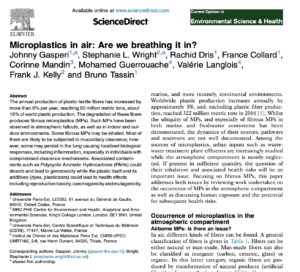This is a summary and explanation of the following research paper:
Microplastics in air: Are we breathing it in?
- Published In: Current Opinion in Environmental Science & Health
- In: Feb 2018

Key Takeaways:
- Air samples were taken from indoor (two apartments and one office) and outdoor locations (two locations on the roofs of buildings).
- Microplastics were found in samples from all areas in the study. The study reported that concentrations of fibers, including microplastics, were present in both indoor and outdoor air.
- The indoor concentrations ranged between 1.0 and 60.0 fibers per cubic meter, while outdoor concentrations were significantly lower, ranging between 0.3 and 1.5 fibers per cubic meter.
Research Paper Summary
The study “Microplastics in air: Are we breathing it in?” focuses on the presence and potential health impacts of airborne microplastics, particularly fibrous microplastics (MPs), in various environments. Here are the main points:
- Increasing Production of Plastic Textile Fibers: The study notes the significant increase in plastic textile fiber production, which contributes to the generation of fibrous microplastics. These fibers are found in atmospheric fallout and both indoor and outdoor environments.
- Inhalation and Health Risks: There’s concern that some fibrous microplastics can be inhaled. While many are likely cleared by the body’s mucociliary clearance mechanisms, some may persist in the lungs, particularly in individuals with compromised clearance mechanisms. This persistence can cause biological responses like inflammation.
- Contaminants: Fibrous microplastics can carry contaminants like Polycyclic Aromatic Hydrocarbons (PAHs) and additives from plastics (e.g., dyes, plasticizers), which could lead to health effects like reproductive toxicity, carcinogenicity, and mutagenicity.
- Occurrence and Characteristics in the Environment: The study reviews findings on the occurrence of fibrous MPs in the air and their characteristics. It discusses their size, composition, and concentration levels in different environments, including the differences found in indoor and outdoor air.
- Human Exposure: The potential for human exposure to fibrous MPs through inhalation and accumulation in the human body is addressed. The study suggests that fibrous MPs are durable and likely to persist in the lung.
- Occupational Health Risks: The study highlights specific health risks for workers in industries that handle synthetic fibers, such as increased respiratory irritation and interstitial lung disease.
- Potential Mechanisms of Toxicity: The study explores the potential mechanisms by which fibrous MPs could cause harm, including inflammation, secondary genotoxicity due to the formation of reactive oxygen species, and possible links to fibrosis and cancer.
- Recommendations: The authors call for more research to better understand the human health impacts of fibrous MPs, emphasizing the need for collaboration across various scientific disciplines and recommending specific approaches for monitoring and reporting.
